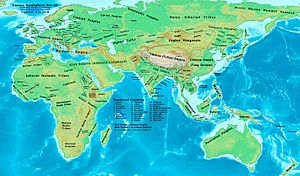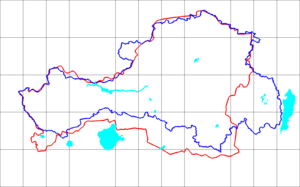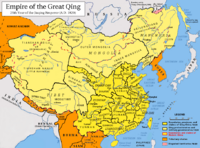History of Tuva facts for kids
The land we now call Tuva has a very long and interesting history. Many different groups of people have lived here over thousands of years. It's sometimes hard to know all the details of Tuva's early history because there aren't many clear written records.
However, we do know that people like the Scythians were here as early as 900 BC. Tuva was often taken over by powerful empires that swept across Central Asia. It was likely ruled by different Turkic groups until the year 1207. After that, various Mongol leaders, including those from the Yuan dynasty, controlled Tuva until the 1700s. Then, the Manchu-led Qing dynasty took over.
Later, in the 1800s, Russia started to settle in the area. This led to Tuva becoming part of Russia in the 1900s. It was controlled by the Russian Empire and then the Soviet Union. Finally, in 1992, Tuva joined the Russian Federation. What's interesting is that through all these changes, Tuva's borders have stayed pretty much the same!
Contents
Ancient Times: Early People of Tuva
It's tricky to find many written records about Tuva before the mid-1700s. Also, old writings sometimes don't clearly separate the people of Tuva (called Tannu Uriankhai) from other similar groups. Generally, Tuva was often taken over by different empires without much fighting.
Who Lived Here First?
Archaeologists have found signs that people have lived in what is now Tuva for a very long time. They've discovered ancient tombs from the late Stone Age. Some of the most amazing finds are from the Scythian people near a place called Arzhaan in northern Tuva. These discoveries date back to between 700 and 900 BC. They are some of the oldest and most eastern Scythian finds known! After being carefully put back together in St Petersburg, a huge treasure of gold from these sites is now on display in the National Museum in Kyzyl.
Early Empires and Tribes
The Xiongnu empire ruled over Tuva before 200 AD. Scholars believe the Xiongnu might have been Mongolic or Turkic people. At this time, a group known to the Chinese as the Dingling lived in the region. The Chinese also wrote about a Dingling tribe called Dubo in the eastern Sayan Mountains. Many believe this name is linked to the Tuvan people, making it the earliest written record of them.
Later, the Xianbei defeated the Xiongnu, and then the Rouran defeated the Xianbei. From around the late 500s, the Göktürks controlled Tuva. They ruled until the 700s, when the Uyghurs took over.
The Tuvan People and Their Language
The people who originally lived in the Tuva Republic today speak a Turkic language. This language has strong influences from Samoyedic and Mongolian languages. The name "Tuva" likely comes from a Samoyedic tribe. Chinese records from the 600s called them Dubo or Tupo, and they lived near the upper Yenisei River. The Chinese and Mongols also knew these people as Uriankhai.

Tuvans were part of the Uyghur Khaganate during the 700s and early 800s AD. The Uyghurs built forts in Tuva to control the local people. In 840 AD, a rebellion by the Yeniseian Kyrgyz (who came from the upper Yenisei River) overthrew the Uyghur Khaganate. Some Uyghurs then joined Tuvan society. The Kyrgyz ruled Tuva until the 1200s.
Mongol Rule: A New Era
In 1207, the Mongols, led by Jochi (the eldest son of Genghis Khan), conquered Tuva. This marked the beginning of Mongol control over the Tuvans. For a while, Tuvans were ruled by the Khalka Mongol leader Sholoi Ubashi, whose state was called the Altyn-Khan Khanate. This lasted until the 1600s.
The Altyn-Khan state eventually disappeared because of constant wars between the Oirats and the Khalka Mongols. The Tuvans then became part of the Dzungarian state, which was ruled by the Oirats. The Dzungars controlled the entire Sayano-Altay Plateau until 1755.
The historical region of Tannu Uriankhai, which includes Tuva, was under Mongol control from 1207 to 1757. After that, it came under the rule of the Qing dynasty, which was the last dynasty of China. This lasted until 1911.
Tuva was also part of the Yuan dynasty of China (1271–1368). After the Yuan dynasty fell, the Oirats controlled the area until the late 1500s and early 1600s. The region of modern Tuva has been ruled by many different states throughout history, including the Xianbei state, Rouran Khaganate, Mongol Empire, Yuan dynasty, Northern Yuan dynasty, and Dzungar Khanate.
Qing Dynasty Control
The Qing dynasty took control of the Khalkha Mongols after helping them in a war against the Oirats. In 1691, the Kangxi Emperor accepted the Khalkhas' surrender. He then personally led an army against the Oirat leader Galdan and defeated him in 1696. The Khalkha Mongols and some Uriankhais were now under Qing rule. However, the Dzungar Empire still controlled the area of modern-day Tuva.
In 1726, the Yongzheng Emperor told a Khotogoit Khan to go with a Qing official to "inform the Uriankhais of [Qing] orders." This was to prevent any trouble. The Qing took control of other Uriankhai groups later, in 1754, as part of a bigger military effort against the Dzungar Empire.
Tannu Uriankhai Under Qing Rule
The Tannu Uriankhai people were organized into an administrative system similar to Mongolia's. They had five khoshuns (like provinces) and 46 or 47 sumuns (smaller districts). Each khoshun was led by a prince whose position was passed down through his family. These princes were officially appointed by the Qing military governor in Uliastai. Later, one of these princes became the main governor (called "amban-noyon") because of his military service to the Qing dynasty.
Tannu Uriankhai had a special place in the Qing Dynasty's border system. Qing laws clearly set out rules for nobles in other parts of Mongolia regarding taxes and meetings with the emperor. But these laws didn't mention Tannu Uriankhai. After the border between China and Russia was set by the Treaty of Kyakhta in 1727, the Qing placed border guards south of the Tannu-ola Mountains. These mountains separated Tannu Uriankhai from Outer Mongolia, not from Russia. This fact was later used by Russian writers to say that Tuva was historically "disputed" land between Russia and China.
The Qing military governor never crossed the Tannu-ola mountains to visit Uriankhai during his inspections. If there were problems, he would send a Mongol from his staff instead. After the treaty, people in Uriankhai who didn't have citizenship with either side had to pay taxes to both Russia and China.
No high-ranking Qing official ever visited Tannu Uriankhai (except in 1726). Chinese merchants were not allowed to cross the border into Uriankhai until the early 1900s. Instead, trade happened for a few days in Uliastai. Uriankhai nobles would bring their yearly fur taxes to the military governor and receive their salaries and gifts from the emperor, like satin and cotton cloth. This meant Tannu Uriankhai had more political and cultural freedom than other border regions of China.
Russian Settlers Arrive
During the 1800s, Russians started to settle in Tuva. In 1860, a treaty between China and Russia allowed Russians to live there, as long as they stayed in boats or tents. Russian gold miners arrived as early as 1838 to find gold. By 1885, almost 9,000 kilograms of gold had been taken out of the region.
In 1881, Russians were allowed to build permanent homes. By this time, a good number of Russians had settled. Their affairs were managed by a Russian official who also helped solve problems and check on Tuvan chiefs. By 1883, there were 485 Russian miners.
Russian merchants from Minusinsk also came, especially after the Treaty of Peking in 1860, which opened China to foreign trade. They were attracted by the high prices Tuvans would pay for Russian goods like cloth, sewing items, samovars (tea urns), knives, and tobacco. By the late 1860s, there were 16 Russian trading posts in Tannu Uriankhai. Tuvans paid for these goods with livestock (sheep, goats, horses, cattle) and animal furs and skins. Traveling over the Sayan Mountains was difficult, so by 1880–85, there were probably no more than 50 Russian traders active in the summer.
Russian colonization continued. It began in 1856 with a group of Old Believers (a Christian sect) who were looking for a remote place to live. More Russians arrived, including those escaping prison in Siberia. Small settlements grew in northern and central Tuva.
Official Russian colonization in Tannu Uriankhai started in 1885. A merchant got permission to farm near what is now Turan. More settlements formed, and by the early 1900s, there were about 2,000 Russian merchants and settlers.
By the late 1870s and 1880s, Russia also had a political presence. In 1878, Russians found gold in eastern Uriankhai. There were rumors of great wealth, and Russian officials received many requests from gold miners. Permission was given. Merchants and miners asked Russian authorities for protection. In 1886, the Usinsk Frontier Superintendent office was created. Its main job was to represent Russian interests to Tuvan nobles (not Qing officials) and to issue passports to Russians traveling in Uriankhai. Over time, this office quietly started to govern the Russians in the region, handling taxes, policing, and justice. These powers officially belonged to the Qing, but they effectively gave them up.
The Russian government was careful not to act too quickly in Uriankhai, fearing it would upset the Qing. They preferred a slower approach, encouraging colonization rather than military action. This was different from how Russia gained influence in Outer Mongolia, where they were mainly traders. In Uriankhai, Russians built permanent farms, cleared land, put up fences, and raised animals. They were there to stay. The Russian presence became stronger because they settled in the northern and central parts of Tannu Uriankhai, areas where few native people lived. So, Russian colonization, rather than direct Russian aggression, led to Tannu Uriankhai eventually becoming part of Russia.
Qing Dynasty's Response
The Qing government knew about the Russian presence. In the 1860s and 1870s, the Uliastai military governor repeatedly reported the arrival of Russians to the Qing. During talks for the Treaty of Tarbagatai in 1864, the Russian representative insisted that all land north of the Qing border belonged to Russia. Also, the Uliastai military governor got a Russian map that showed the Tannu-ola Mountains as the border. These events worried the Qing.
However, in the second half of the 1800s, the Qing government was busy with internal problems and couldn't deal with these issues effectively. Local officials on the border were left to manage the Russians as best they could, which was impossible without money or troops. The military governors could only make weak protests and conduct unclear investigations. By 1909, it was recorded that 9,000 Russians had settled in Tannu Uriankhai.
Tuva Becomes Independent
By the early 1900s, the economy in Uriankhai had gotten much worse, leading to more poverty. There were several reasons for this decline: fewer fur-bearing animals due to too much hunting by both Uriankhais and Russians; fewer livestock because they were being sold to Siberia; and natural disasters like droughts and diseases, which further reduced animal populations.
The decrease in squirrels also caused a lot of inflation. Trade with Russians was done on credit, and the value was mostly based on squirrel skins. Russians also encouraged people to buy on credit with very high interest rates. If people couldn't pay back their debts, Russian merchants would take their livestock or the livestock of their relatives or friends. This sometimes led to Uriankhais attacking in return.
Because of Qing policy, Han traders were kept out of Uriankhai. This policy was actually enforced, unlike in other border regions like Mongolia. In 1902, Han traders were allowed to cross the border to break the Russian control of the Uriankhai economy. By 1910, there were about 30 shops, all branches of Han-owned companies that also operated in Uliastai. Because they sold more aggressively, offered easier credit, and had cheaper and more popular goods, the Han quickly came to control trade, just as they had in Mongolia. Soon, Tuvans, both common people and princes, owed large amounts of money to Han merchants.
Qing rule in Tannu Uriankhai ended quickly. On October 10, 1911, the Wuchang Uprising started a full-scale revolution to overthrow the Qing dynasty. Soon after, many Chinese provinces declared their independence. Outer Mongolia declared its own independence from China on December 1st and sent away the Qing viceroy four days later. In the second half of December, groups of Uriankhai people started robbing and burning Han-owned shops.
Uriankhai nobles had different ideas about what to do next. The Uriankhai governor, Gombo-Dorzhu, wanted Tuva to become a protectorate of Russia. He hoped the Russians would then make him governor of Uriankhai. But the princes of two other khoshuns preferred to join the new Outer Mongolian state, which was ruled by the Jebstundamba Khutukhtu of Urga. There were also nobles who wanted Tuva to be a completely independent country.
Gombu-Dorzhu sent a request to the Frontier Superintendent in Usinsk, saying he had been chosen as the leader of an independent Tannu Uriankhai state. He asked for protection and for Russian troops to be sent immediately to prevent China from taking back control. There was no reply because three months earlier, the Russian government had already decided on a policy of slowly and carefully taking over Uriankhai by encouraging Russian settlement. Russia feared that acting too quickly might upset China.
However, this position changed. Russia became genuinely worried about the safety of Russian lives and property in Uriankhai. Business groups in Russia also pushed for a more active approach. In the fall of 1913, two Uriankhai khoshuns formally asked to become part of Russia. Other Uriankhai khoshuns soon followed. In April 1914, Tannu Uriankhai was officially accepted as a protectorate of Russia.
Russian interests in Tuva continued into the 1900s.
Tuva Joins Tsarist Russia
During the Wuchang Uprising (the 1911 revolution in China), tsarist Russia encouraged Tuvans to seek independence. Tsar Nicholas II sent Russian troops into Tuva in 1912, saying that Russian settlers were being attacked. Tuva became officially independent as the Urjanchai Republic for a short time. Then, on April 17, 1914, it became a Russian protectorate called the Uryankhay Kray. This was requested by several important Tuvans, including the High Lama (a Buddhist leader). A capital city for Tuva was created and named Belotsarsk (meaning "Town of White Tsar"). Around the same time, in 1911, Mongolia also became independent but under Russian protection.
After the Russian Revolution of 1917, which ended the Tsar's rule, most of Tuva was taken over by Aleksandr Kolchak's "White" Russian troops from July 1918 to July 1919. Pyotr Ivanovich Turchaninov was made governor. In late 1918, Chinese troops occupied the southwestern part, and Mongol troops led by Khatanbaatar Magsarjav occupied the southern part.
Communist Tuva
From July 1919 to February 1920, the communist Red Army controlled Tuva. But from February 1920 to June 1921, China occupied it again under governor Yan Shichao. On August 14, 1921, the Bolsheviks (with Russia's support) created the Tuvan People's Republic, often called Tannu-Tuva. In 1926, the capital city (which had been renamed Khem-Beldyr in 1918) was renamed Kyzyl, which means "Red." Tuva was an independent country between World War I and World War II.
Tuva's first communist leader, Prime Minister Donduk, wanted to make ties stronger with Mongolia and make Buddhism the official state religion. This worried the Soviet leaders in Moscow. So, in 1929, they arranged a coup carried out by five young Tuvan students who had studied in Moscow. In 1930, the new pro-Soviet government started to change the writing system. First, they replaced the Mongol script with a Latin alphabet, and then in 1943, they adopted the Cyrillic alphabet (like Russian). Under the leadership of Party Secretary Salchak Toka, ethnic Russians were given full citizenship rights, and Buddhist and Mongol influences on Tuvan society were slowly reduced.
During World War II, Tuva sent infantry, armored, and cavalry troops to fight against Nazi Germany. Under Soviet command, many units fought bravely and received Tuvan medals.
Tuva Joins the Soviet Union
The Soviet Union officially took over Tuva on October 11, 1944. This was supposedly approved by Tuva's parliament (the Little Khural), but there was no public vote on the matter. The exact details of how Tannu-Tuva became part of the USSR in 1944 are still not fully clear. Salchak Toka, the leader of the Tuvan People's Revolutionary Party, became the First Secretary of the Tuvan Communist Party. He was the main ruler of Tuva until he died in 1973. Tuva became the Tuvan Autonomous Oblast and then, on October 10, 1961, it became the Tuvan Autonomous Soviet Socialist Republic. The Soviet Union kept Tuva closed off from the rest of the world for almost 50 years.
Tuva in Modern Times
In February 1990, the Tuvan Democratic Movement was started by Kaadyr-ool Bicheldei, a language expert from Kyzyl University. This group wanted to create more jobs and housing, and also to improve the status of the Tuvan language and culture.
Tuva signed a treaty on March 31, 1992, which created the Russian Federation. A new constitution for the republic was written on October 22, 1993. This constitution created a 32-member parliament (Supreme Khural) and a Grand Khural. The Grand Khural is in charge of foreign policy and any changes to the constitution, and it makes sure that Tuvan law is followed. The constitution also allowed for a public vote if Tuva ever wanted to become fully independent. This constitution was approved by 53.9% (or 62.2%, depending on the source) of Tuvans in a vote on December 12, 1993.
Images for kids
-
Map showing extent of the Uyghur Khaganate and the location of Kyrgyz in 800 AD.
See also
- Aldy-Bel culture








